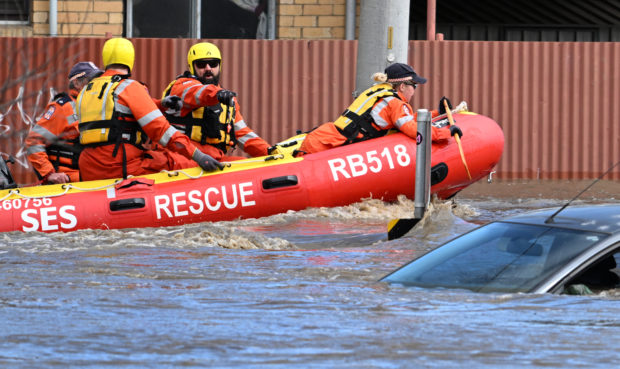Floods leave thousands stranded in Australia, as PM warns of ‘dangerous times ahead’

Emergency workers look at a submerged car on a flooded street in the Melbourne suburb of Maribyrnong on October 14, 2022. AFP FILE PHOTO
SYDNEY – Flooding across south-east Australia has led to mass evacuations and raised concerns about the country’s food supplies as it experiences the damaging effects of a third consecutive La Nina event.
As rain continued across the south-east region on Monday, authorities warned that 34,000 homes in the state of Victoria could be flooded or isolated.
Flooding is also affecting the states of New South Wales and Tasmania, after the south-east region was hit last week by more than a month’s worth of average rainfall.
The bouts of heavy rain in recent years have meant that grounds are already drenched, so further downpours can cause almost immediate flooding and overflows of rivers and waterways.
Visiting affected areas in New South Wales on Monday, Prime Minister Anthony Albanese said Australia was facing “dangerous times” from heavy deluges that are affecting roads, farms and infrastructure. He warned residents to heed warnings from authorities to evacuate before being stranded by floodwaters.
“We are living in very dangerous times in the days and weeks ahead,” he told reporters. “Essentially, a single drop of rain has nowhere else to go except stay on the surface because of the flooding that has occurred over a period of time.”
In Victoria, the floods are already believed to have caused damage worth hundreds of millions of dollars to homes, farms and businesses. More than 100 Australian Defense Force troops have been dispatched to the state to support evacuations and sandbagging.
The flooding has affected parts of Melbourne, Australia’s second most populous city, and left towns in northern Victoria stranded.
As inland rivers reached record highs, nearby communities have been desperately building sandbag walls to try to avoid or minimise the flooding. In some towns, residents have used boats and kayaks to make their way through flooded roads.
Victoria Premier Daniel Andrews announced an A$351 million (S$313 million) package on Monday to support emergency housing and to assist with the clean-up effort, including A$165 million for urgent transport needs such as fixing potholes and rebuilding bridges.
“There isn’t a second to waste as we begin recovery in flood-affected communities, whether it’s support for households, clean-ups or local roads,” he said in a statement.
But further rain and severe thunderstorms are expected to occur over much of eastern and south-eastern Australia later this week. The Bureau of Meteorology said on Monday that some areas will receive as much as 100mm of rain.
“Unfortunately, particularly in New South Wales and Victoria, we have a long way to go in terms of flooding and it’s too hard to say at this stage when it will finally end,” a senior meteorologist at the bureau, Mr Dean Narramore, told ABC News.
The floods have caused heavy damage to some of the nation’s most productive farmland and have led to losses of livestock and wheat, barley, fruit and vegetables. Authorities warned that prices of groceries and staples such as milk – which are already high due to soaring inflation – will further increase.
“We need to brace ourselves for the impact of these natural disasters on the cost of living,” Treasurer Jim Chalmers told reporters. “We are talking here about some of the best growing and producing country in Australia.”
Australia has rarely experienced three consecutive La Nina events, though this is believed to have occurred in 1954-57, 1973–1976 and 1998–2001. In the country, La Nina events increase the chances of extra rain in spring and summer.
Experts believe the current La Nina event could peak in November and be over by early 2023. But the coming weeks of further rain could be grim, especially as many regions in eastern Australia have already been flooded in the past year and have little capacity to absorb more water.
Unfortunately, there is still a chance that there could be a fourth La Nina next year.
“We’ve had La Nina three years in a row, so a fourth time in a row is less common,” climate researcher Agus Santoso from the University of New South Wales told the 7News website.
“But it’s not impossible. At this stage, we cannot predict that far ahead.”
RELATED STORIES
Australia PM to tour flood-hit Victoria state; evacuations, sandbagging underway
Australia suffers flash floods in southeast, Melbourne suburb evacuated